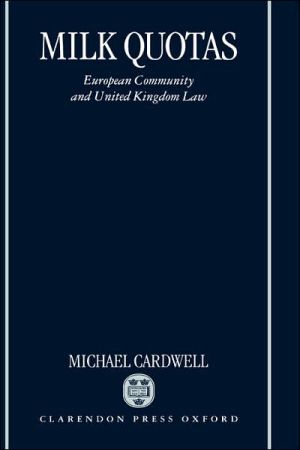Milk Quotas: European Community and United Kingdom Law
Since their introduction in 1984, milk quotas have become a prominent feature of the Common Agricultural Policy. This indispensable and up-to-date practitioner's manual explores the astonishing influence that milk quotas have had on both EC and UK legislation. The author examines exactly how these quotas have impacted on landlords, tenants, taxation and, consequently, on rural culture itself. While exploring milk quotas on a national level, the author consistently links critical localized...
Search in google:
Since their introduction in 1984, milk quotas have become a prominent feature of the Common Agricultural Policy. This indispensable and up-to-date practitioner's manual explores the astonishing influence that milk quotas have had on both EC and UK legislation. The author examines exactly how these quotas have impacted on landlords, tenants, taxation and, consequently, on rural culture itself. While exploring milk quotas on a national level, the author consistently links critical localized issues to their far-ranging ramifications as milk quota legislation becomes an increasingly contested issue at the European Court of Justice and a catalyst for legislative reform within the wider context of the EC itself. Jerry Waltman Book reviewers are often justly criticized for wishing the author had written another book. At times, though, the character of a book may be what readers of a review most want to know. Unless you have a burning desire to read everything published on milk or are preparing to argue a case before the European Court, you are unlikely to want to read this book. Its purpose is to be an "indispensable and up-to-date practitioner s manual." As such, it is a thorough and workmanlike tour through the regulations and court decisions regarding the European Union s milk quota system, first adopted in 1984. Three chapters discuss the early legislation and the problems it encountered. Three additional chapters take up the legal impact these measures had in the United Kingdom on quota transfers, landlord-tenant relations, and taxation. The approach is topical and the style legalistic description. Two examples, drawn almost at random, will suffice to present the flavor: "Under this provision, an æadditional reference quantity could be granted to producers realizing a development plan approved after the implementation of the milk quota system under Directive 72/159/EEC, subject to the plan meeting certain criteria." (P. 18) Or, "[W]ith regard to compensation payable under the Agriculture Act 1986 a fourth alternative may be suggested, namely that the sums received fall out of the tax net altogether by an analogy with statutory compensation payable under section 60 of the AHA 1986 or section 37 of the Landlord and Tenant Act 1954." (P. 193) In short, this volume is really more akin to a reference work than a scholarly monograph. While full of information, it is completely devoid of any kind of framework or historical perspective. There is not a single reference to any work on economics, public administration, federalism, British constitutional theory, modes of judicial interpretation, transnational institutions, or British or European history. This is frustrating to a political scientist because the material is bristling with theoretical questions. Let me offer three brief but cogent examples. Students of the administration of regulatory policy could hardly be handed a better case study. The imposition of milk quotas created an instant economic value in the assignments. To prohibit a market from developing in the quotas, with profits accruing to speculators and high barriers being erected for new entrants, the Commission (the EU policy making body) adopted a rule that quota transfers could only take place as part of a land transaction. Human creativity being what it is, though, sham land transaction schemes proliferated, requiring yet more regulations. Moreover, not surprisingly, each new regulation generated a number of court cases. Nevertheless, the policy s twin goals were met: milk production declined and farmers incomes rose. It is also a fascinating study of administrative issues in federal or quasi-federal political systems. The Commission relied, in line with customary practice, on national bureaucracies to allocate quotas among farmers within each country. In 1992, the Court of Auditors (another EU institution) found that Greece, Italy, and Spain had not fully complied. I could not help but recall the debates during the waning days of the Articles of Confederation, when political thinkers wrestled with the thorny problem of how to create a political order that would ensure that the states would actually carry out national legislation. Fortunately for the United States, of course, the legal groundwork was laid for a national bureaucracy. Is there any other workable arrangement? Is talk of federalism in the EU pointless as long as Eurocrats are only resident in Brussels? The Commission took the laggards to court and obtained a judgment. What happened next we are not told. Finally, there is the matter of British constitutional law. The touchstone of Britain s uncodified constitution, Parliamentary sovereignty, has always been at odds with the power exercised by EU institutions. The English courts have held that so long as the Act of Parliament implementing the EU treaty remains in force, Parliament has given its sanction to all EU regulations; of course, Parliament could repeal the act any time it chooses. However, the British constitution changes by the evolution of conventions, practices accepted by all major political actors. Could it be that if the EU s regulatory web is allowed to stand for long enough it will become a convention? Will these specialized areas of public policy, in time, have more impact on British constitutional practice--and hence on doctrine and theory--than the great debates triggered by such events as the Maastricht Treaty and monetary union? In sum, Cardwell s acknowledged purpose, to compile and annotate the regulations and court decisions regarding EU milk quotas and provide copious notes on how these have affected aspects of British law, was accomplished admirably. Reading the book, though, left me, for one, wishing for a serving of cookies to go along with it.
AcknowledgementsTable of CasesIntroduction11The Introduction of Milk Quotas52The Continuing Surplus and Further Allocations413Reform and the Current Legislation694Quota Transfers915Landlord and Tenant Issues1376Taxation1797Conclusion201Further Reading207Index211
\ Jerry WaltmanBook reviewers are often justly criticized for wishing the author had written another book. At times, though, the character of a book may be what readers of a review most want to know. Unless you have a burning desire to read everything published on milk or are preparing to argue a case before the European Court, you are unlikely to want to read this book. Its purpose is to be an "indispensable and up-to-date practitionerÆs manual." As such, it is a thorough and workmanlike tour through the regulations and court decisions regarding the European UnionÆs milk quota system, first adopted in 1984. Three chapters discuss the early legislation and the problems it encountered. Three additional chapters take up the legal impact these measures had in the United Kingdom on quota transfers, landlord-tenant relations, and taxation. The approach is topical and the style legalistic description. Two examples, drawn almost at random, will suffice to present the flavor: "Under this provision, an æadditional reference quantityÆ could be granted to producers realizing a development plan approved after the implementation of the milk quota system under Directive 72/159/EEC, subject to the plan meeting certain criteria." (P. 18) Or, "[W]ith regard to compensation payable under the Agriculture Act 1986 a fourth alternative may be suggested, namely that the sums received fall out of the tax net altogether by an analogy with statutory compensation payable under section 60 of the AHA 1986 or section 37 of the Landlord and Tenant Act 1954." (P. 193) In short, this volume is really more akin to a reference work than a scholarly monograph. While full of information, it is completely devoid of any kind of framework or historical perspective. There is not a single reference to any work on economics, public administration, federalism, British constitutional theory, modes of judicial interpretation, transnational institutions, or British or European history. This is frustrating to a political scientist because the material is bristling with theoretical questions. Let me offer three brief but cogent examples. Students of the administration of regulatory policy could hardly be handed a better case study. The imposition of milk quotas created an instant economic value in the assignments. To prohibit a market from developing in the quotas, with profits accruing to speculators and high barriers being erected for new entrants, the Commission (the EU policy making body) adopted a rule that quota transfers could only take place as part of a land transaction. Human creativity being what it is, though, sham land transaction schemes proliferated, requiring yet more regulations. Moreover, not surprisingly, each new regulation generated a number of court cases. Nevertheless, the policyÆs twin goals were met: milk production declined and farmersÆ incomes rose. It is also a fascinating study of administrative issues in federal or quasi-federal political systems. The Commission relied, in line with customary practice, on national bureaucracies to allocate quotas among farmers within each country. In 1992, the Court of Auditors (another EU institution) found that Greece, Italy, and Spain had not fully complied. I could not help but recall the debates during the waning days of the Articles of Confederation, when political thinkers wrestled with the thorny problem of how to create a political order that would ensure that the states would actually carry out national legislation. Fortunately for the United States, of course, the legal groundwork was laid for a national bureaucracy. Is there any other workable arrangement? Is talk of federalism in the EU pointless as long as Eurocrats are only resident in Brussels? The Commission took the laggards to court and obtained a judgment. What happened next we are not told. Finally, there is the matter of British constitutional law. The touchstone of BritainÆs uncodified constitution, Parliamentary sovereignty, has always been at odds with the power exercised by EU institutions. The English courts have held that so long as the Act of Parliament implementing the EU treaty remains in force, Parliament has given its sanction to all EU regulations; of course, Parliament could repeal the act any time it chooses. However, the British constitution changes by the evolution of conventions, practices accepted by all major political actors. Could it be that if the EUÆs regulatory web is allowed to stand for long enough it will become a convention? Will these specialized areas of public policy, in time, have more impact on British constitutional practice--and hence on doctrine and theory--than the great debates triggered by such events as the Maastricht Treaty and monetary union? In sum, CardwellÆs acknowledged purpose, to compile and annotate the regulations and court decisions regarding EU milk quotas and provide copious notes on how these have affected aspects of British law, was accomplished admirably. Reading the book, though, left me, for one, wishing for a serving of cookies to go along with it.\ \








